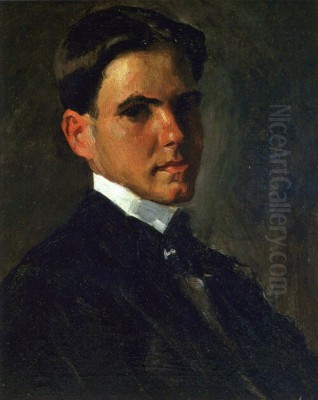
Julian Onderdonk stands as a pivotal figure in American art history, particularly celebrated for his evocative depictions of the Texas landscape. Born Robert Julian Onderdonk in San Antonio, Texas, in 1882, he inherited an artistic lineage and developed a style deeply rooted in American Impressionism. His luminous paintings, especially those capturing the vibrant bluebonnets of his home state, earned him the enduring title "Father of Texas Painting." Though his life was tragically cut short in 1922 at the age of forty, his work continues to resonate, offering a unique window into the natural beauty of the American Southwest as seen through an Impressionist lens.
Early Life and Artistic Beginnings
Julian Onderdonk's journey into art began almost at birth. His father, Robert Jenkins Onderdonk, was himself a respected painter and art teacher, providing Julian with his earliest instruction and fostering his innate talent. Growing up in an artistic household in San Antonio meant that exposure to painting techniques and artistic discourse was a part of daily life. Robert Onderdonk, having studied in New York, brought a level of sophistication and connection to the broader American art scene to his son's early training.
Even during his formal education, Julian's artistic inclinations were evident. In 1898, he attended the West Texas Military Academy, where he didn't just study but actively contributed his skills, serving as the art editor for the school publication, Bugle Notes. Demonstrating both talent and initiative, he also found time outside his own studies to teach art classes, an early indication of his commitment to the visual arts. His father continued to guide his development remotely through written critiques, ensuring his artistic education progressed steadily even before he sought more formal training.
This early foundation, blending paternal guidance with practical application at the military academy, set the stage for Onderdonk's departure to the center of the American art world at the turn of the century. His Texas roots, however, would remain a profound source of inspiration throughout his career.
Formative Years in New York
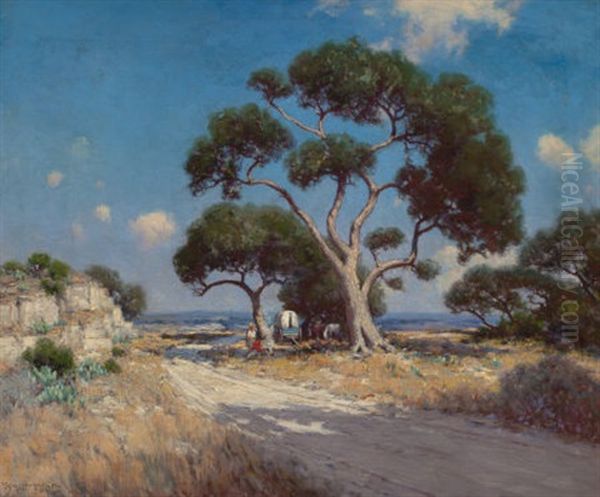
In 1901, seeking to refine his skills and immerse himself in the contemporary art scene, Julian Onderdonk moved to New York City. He enrolled in the prestigious Art Students League of New York, an institution co-founded years earlier by artists including his own father, Robert Jenkins Onderdonk. This connection likely eased his transition, placing him within an environment familiar through family history and respected for its progressive approach to art education, which had nurtured talents like Kenyon Cox, a contemporary of his father's studies there.
The most significant influence during his New York period was undoubtedly William Merritt Chase. A leading figure in American Impressionism and a charismatic teacher, Chase had also been an influence on Robert Onderdonk. Julian studied directly under Chase, absorbing his principles and techniques. Crucially, he attended Chase's famous outdoor summer school at Shinnecock Hills on Long Island. It was here that Onderdonk fully embraced the plein air (open-air) painting method, a cornerstone of Impressionism.
Chase encouraged his students to capture the fleeting effects of natural light and atmosphere directly onto the canvas, emphasizing spontaneity and direct observation. This approach profoundly shaped Onderdonk's style, teaching him to see and render the nuances of light and color that would become hallmarks of his Texas landscapes. The influence of French Impressionists like Claude Monet and Pierre-Auguste Renoir, whose work Chase admired and helped popularize in America, was palpable in the emphasis on broken brushwork and vibrant palettes. Onderdonk also studied with other instructors, including Robert James Cox, further broadening his technical foundation during these critical formative years.
The "Lost Years" and Struggles
Despite the invaluable training and exposure gained in New York, Onderdonk's time there was far from easy. This period, sometimes referred to as his "lost years," was marked by significant financial hardship and creative challenges. Establishing oneself as a young artist in the competitive New York art world was difficult, and Onderdonk struggled to make ends meet. Poverty was a constant companion, casting a shadow over his efforts to build a reputation.
While he did participate in some exhibitions, gaining minor recognition, commercial success remained elusive. The pressures of survival often took precedence over purely artistic pursuits. Sadly, many of the works created during this challenging phase have not survived. Whether lost to time, sold out of necessity without proper records, or simply discarded during periods of frustration, a significant portion of his New York output is considered lost, leaving gaps in our understanding of his development during these years.
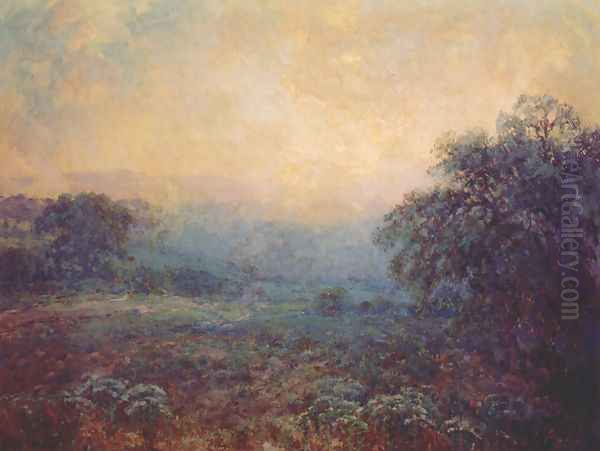
To navigate these difficulties, Onderdonk entered into a commercial arrangement in 1904 with an agent named Charles Tusion, who helped sell his paintings. While providing some much-needed income, this relationship also introduces complexities regarding artistic agency during this period. Furthermore, adding another layer of obscurity, Onderdonk occasionally used the pseudonym "Turner" to sign and sell works, perhaps as a way to generate income without affecting the market for works under his own name, or simply to distance himself from pieces he felt were more commercial than artistic. These struggles underscore the practical realities faced by many artists striving for recognition.
Return to Texas and Artistic Maturity
The cumulative weight of financial strain and the challenges of the New York art market eventually led Julian Onderdonk back to his roots. He returned to San Antonio, Texas, a move that proved pivotal for his artistic career. Reconnecting with the familiar landscapes of his youth provided not just comfort but also a profound source of inspiration that would define his mature work. Free from the immediate pressures of the New York scene, he dedicated himself to capturing the unique beauty of the Texas Hill Country.
It was in Texas that Onderdonk truly found his artistic voice. He became renowned for his depictions of the state's characteristic scenery: rolling hills bathed in the warm Texas sunlight, dusty roads winding through fields, and the distinctive silhouettes of live oak trees. His paintings from this period radiate a deep affection for the land, rendered with the Impressionist techniques he had honed under Chase's tutelage. Works like Oaks in Williams Ranch, Bandera County exemplify his ability to capture the rugged charm and specific atmospheric conditions of the region.
His focus sharpened on subjects that would become his signature themes. He painted the landscape at different times of day and in varying seasons, paying close attention to the way light interacted with the terrain. Early works from this Texas period, such as Sunlight Through the Live Oaks, show his developing mastery in rendering the dappled light filtering through foliage, a motif he would return to frequently. This return home marked not a retreat, but a refocusing that allowed his talent to flourish, cementing his connection to the Texas landscape.
Mastering Light and Color: Impressionist Techniques
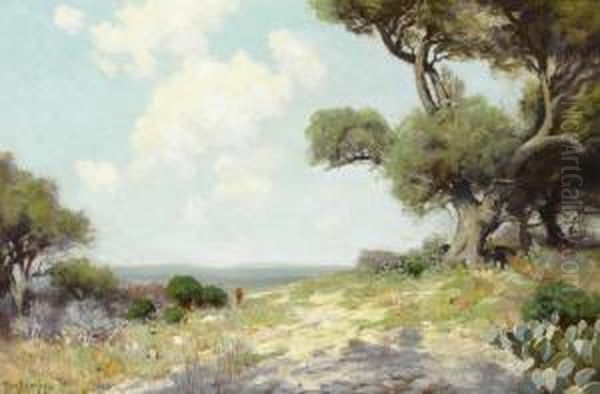
Julian Onderdonk's artistic style is firmly situated within American Impressionism, yet possesses a distinct regional character. His mastery lay in adapting Impressionist principles to the specific light and environment of Texas. Central to his method was plein air painting, learned from William Merritt Chase. Working outdoors allowed him to directly observe and capture the transient effects of sunlight and atmosphere, lending his canvases an immediacy and freshness. He was particularly adept at rendering the intense Texas light, whether the bright glare of midday or the soft glow of dawn and dusk.
His technique involved the characteristic broken brushwork of Impressionism, applying paint in small, distinct strokes that coalesced in the viewer's eye. He often used impasto, applying paint thickly to create surface texture that enhanced the vibrancy of his scenes and conveyed the physicality of the landscape. This is evident in the way he depicted fields of bluebonnets or the rough bark of oak trees. His brushwork could range from loose and energetic in landscape sketches to more controlled in finished studio pieces, but always retained a sense of vitality.
Onderdonk's sensitivity to color was acute. He explored the subtle shifts in hue dictated by light and shadow. His palette evolved over his career; technical studies reveal a shift from lead white towards zinc white and the elimination of certain pigments like vermilion (mercury red) around 1908, suggesting a continuous refinement of his color strategies. He skillfully employed contrasts, as seen in On the Old Blanco Road, where dramatic interplay between light and shadow creates depth and mood. While known for sun-drenched scenes, he also tackled rarer subjects like snow in Texas, using cooler palettes and distinct brushwork, as demonstrated in Snow in the Rocks. His approach shares affinities with fellow American Impressionists like Childe Hassam or John Henry Twachtman in its focus on light, yet remains uniquely attuned to the Texas environment.
Signature Works and Recognition
Julian Onderdonk's reputation rests largely on his iconic depictions of the Texas landscape, particularly his paintings of bluebonnets, the state flower. He is often credited as the originator of the "bluebonnet painting" genre, popularizing the subject to such an extent that fields of these vibrant blue flowers became synonymous with his name. These works captured the public imagination, evoking the beauty and spirit of the Texas spring. His paintings felt immersive; viewers often remarked that they could almost smell the flowers and feel the warm breeze depicted on canvas.
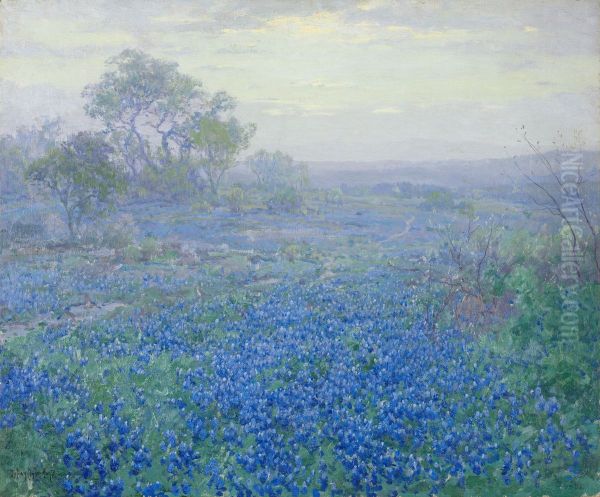
Beyond bluebonnets, several specific works stand out. Dawn in the Hills and Autumn Tapestry are notable examples of his skill in capturing different moods and times of year in the Hill Country. These two paintings gained particular significance when they were exhibited posthumously at the prestigious National Academy of Design in New York as a special tribute. In the Hills – Southwest Texas fetched a significant price (1,450) at auction, indicating the enduring market value and appreciation for his work. Other important pieces include Sunlight Through the Live Oaks and Oaks in Williams Ranch, Bandera County, showcasing his fascination with the interplay of light and foliage.
Onderdonk's work gained considerable recognition during his lifetime, especially after his return to Texas. His paintings were highly sought after, finding favor at exhibitions like the Dallas State Fair, where they consistently won prizes and attracted commissions. His appeal extended beyond Texas, drawing interest from collectors across the United States. He successfully translated the specific beauty of his region into a visual language that resonated widely, securing his place as a major figure in American landscape painting.
Community Involvement and Leadership
Beyond his personal artistic practice, Julian Onderdonk played an active role in fostering the arts community in Texas. Recognizing the need for organized support and promotion of local artists, he became involved in establishing key institutions. He was a co-founder of the San Antonio Art League, one of the earliest and most significant art organizations in the state. The League aimed to elevate the cultural landscape through regular exhibitions, lectures, and art classes, providing crucial opportunities for artists and audiences alike.
Onderdonk was also instrumental in forming The Brass Mug Club, a more informal group of Texas artists. This club provided a space for camaraderie and creative exchange, with members gathering weekly on Sundays to socialize, discuss art, and sketch together. Such initiatives were vital in building a supportive network for artists in a region geographically distant from the established art centers of the East Coast. His leadership and commitment were formally recognized in 1921 when he was made an honorary member of the Texas Fine Arts Association.
Interestingly, some accounts suggest that later in his career, particularly from around 1906 onwards, Onderdonk dedicated increasing energy to organizing art exhibitions. While this demonstrates his commitment to the broader art community, it has also been interpreted by some historians as potentially indicating a shift in his personal focus, perhaps even a waning passion for the solitary act of painting itself, though his output remained significant. Regardless of interpretation, his contributions as an organizer were substantial in developing the infrastructure for visual arts in Texas.
Untimely Death and Legacy
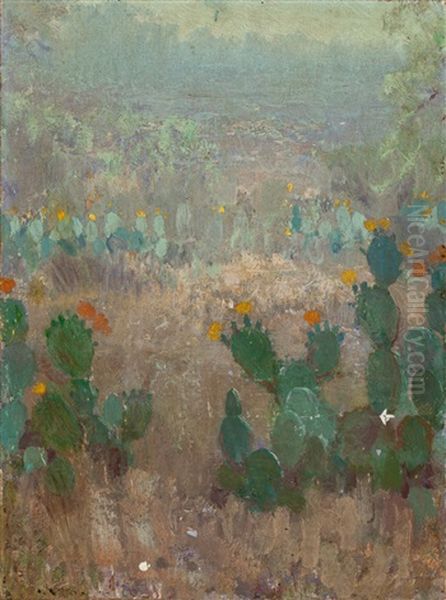
Julian Onderdonk's flourishing career and life were tragically cut short. In October 1922, he suffered an acute intestinal obstruction, likely related to appendicitis, a condition for which he reportedly had a chronic underlying issue. He underwent emergency surgery in San Antonio but sadly passed away shortly thereafter on October 27, 1922, at the young age of forty. His sudden death shocked the Texas art community and cut short a career that was still reaching new heights.
The art world recognized the loss. In a rare and poignant gesture, the National Academy of Design in New York, a bastion of American art, accepted two of his paintings, Dawn in the Hills and Autumn Tapestry, for its winter exhibition shortly after his death, hanging them with special distinction as a tribute to the departed artist. This posthumous honor underscored the national recognition he had achieved.
Julian Onderdonk's legacy is multi-faceted. He is unequivocally the "Father of Texas Painting," not just for popularizing subjects like bluebonnets, but for establishing a high standard for landscape painting in the region, executed with sophisticated Impressionist technique. His work captured the essence of the Texas landscape – its light, colors, and atmosphere – with unparalleled sensitivity. He inspired subsequent generations of Texas artists and helped put Texas art on the national map. His teacher, William Merritt Chase, influenced many artists, including later figures like Georgia O'Keeffe, highlighting a lineage of American painters dedicated to capturing the spirit of place, a tradition Onderdonk masterfully embodied for Texas.
Conclusion
Robert Julian Onderdonk carved a unique and enduring niche in American art. Bridging the sophisticated techniques of Impressionism learned under masters like William Merritt Chase with a deep, personal connection to his native Texas, he created a body of work that celebrates the specific beauty of the American Southwest. His paintings, luminous with the effects of natural light and vibrant color, particularly his iconic bluebonnet landscapes, defined a regional aesthetic and earned him the lasting title "Father of Texas Painting."
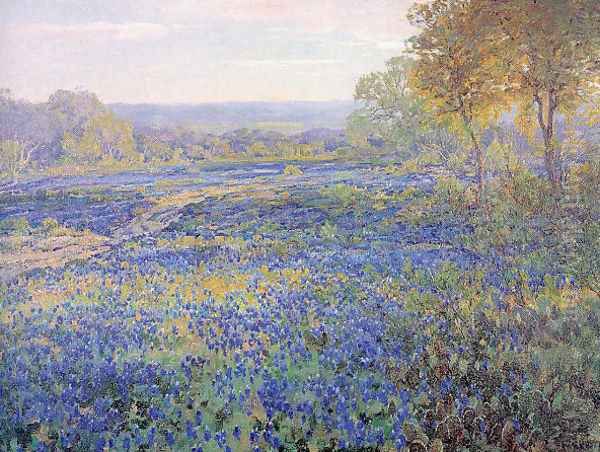
Despite early struggles in New York and a tragically short life, Onderdonk's dedication to his craft and his active role in building the Texas art community left an indelible mark. His ability to convey the atmosphere and character of the Texas Hill Country resonated with audiences both locally and nationally, securing his reputation. Today, his works are cherished not only as beautiful examples of American Impressionism but also as vital documents of the Texas landscape, seen through the eyes of its most devoted and talented interpreter. Julian Onderdonk's legacy lives on in the canvases that continue to evoke the sunlit fields and rolling hills of his beloved home state.